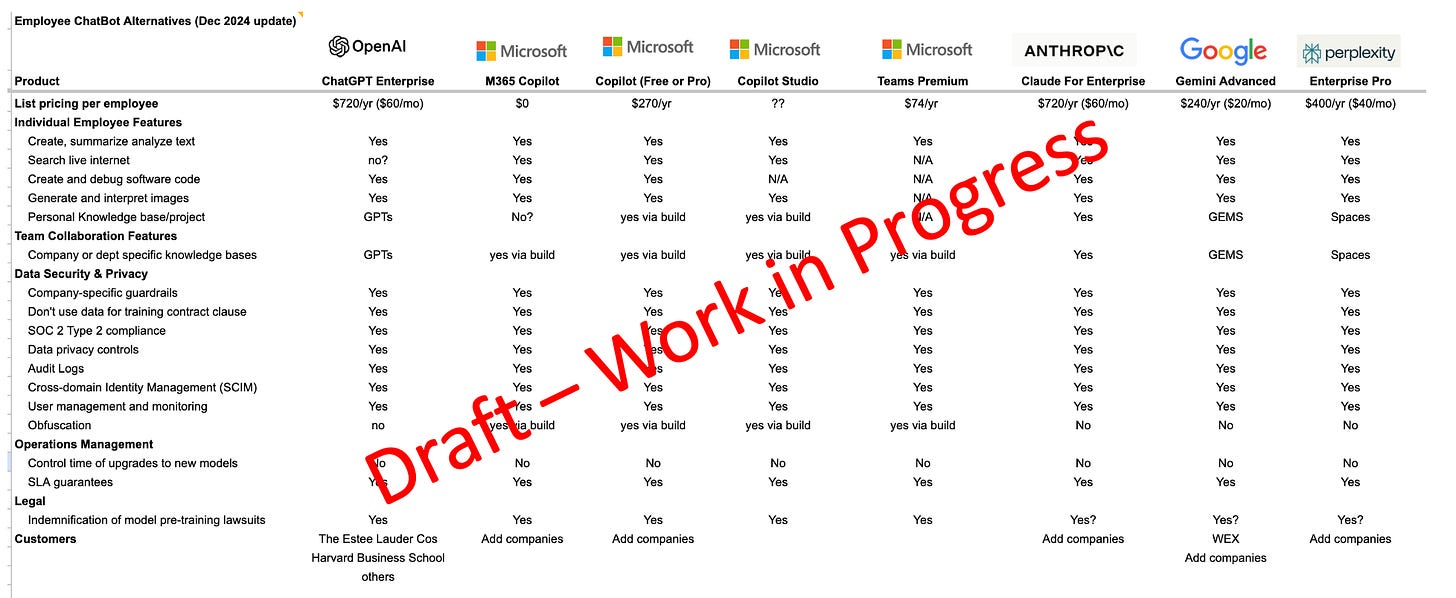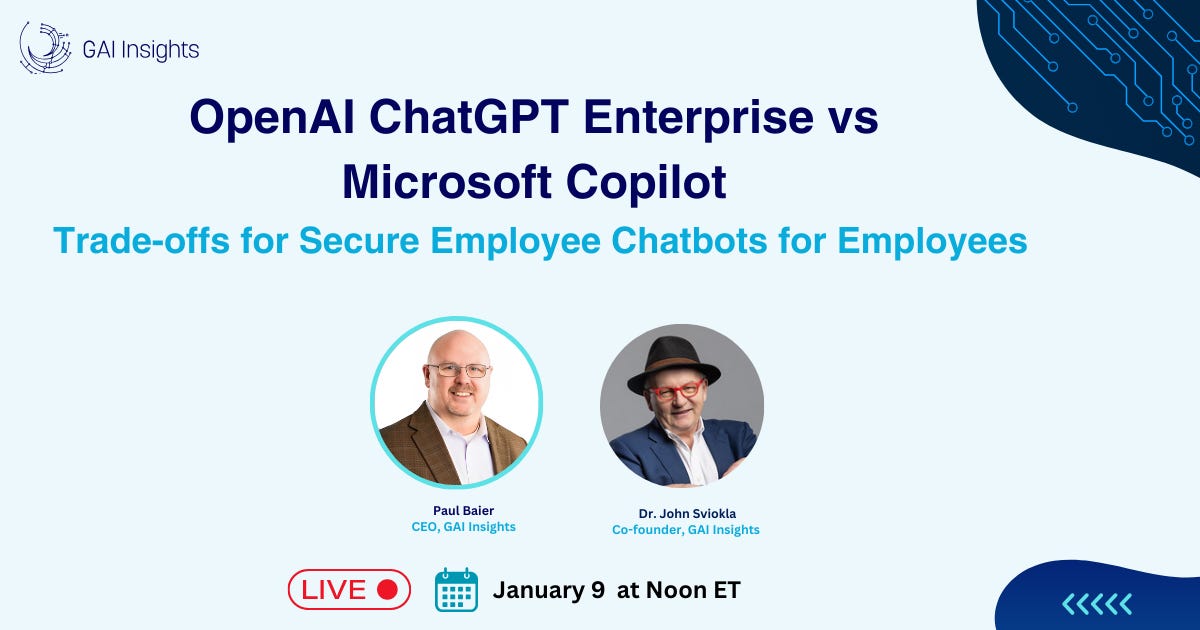WSJ Highlights Confusion with Microsoft Copilot Offerings on Front Page (A1 and B1)
Employees are demanding secure employee chatbots to improve work productivity. Companies need to know the tradeoffs Microsoft Copilot vs OpenAI ChatGPT Enterprise
Wow. Confusion and frustration hits front page of WSJ.
We been hearing this consistently from companies that use our research services.
The WSJ article highlights five customer frustration points with Microsoft related to its Copilot products
Forced integration and pricing. Copilot is being automatically added to Microsoft 365 subscriptions in some regions. Users can't opt out of paying for Copilot even if they don't want it. Price increases apply to all users regardless of AI feature usage
Intrusive user experience. Copilot's rainbow logo pops up frequently during work. The AI assistant appears unsolicited, interrupting workflow, and users can't disable or remove the feature
Pricing structure confusion. The multiple pricing tiers ($20/month for premium Copilot plus $7 for 365, etc.) are confusing. Pricing and implementation options differ by regions, and companies lack of choice in whether to include AI features
Lack of clear communication. Microsoft hasn't explained their strategy for forced Copilot addition. There is no clear explanation of regional implementation differences.
Questionable ROI. Business customers question if the cost is worth the benefits. Concerns also exist AI output accuracy and data privacy protections
Microsoft has completely muddied the situation by having 15+ Copilot products. Here are just a few
Microsoft 365 Copilot
Integrates with Microsoft 365 applications like Word, Excel, PowerPoint, Outlook, and Teams to enhance productivity by generating text, summarizing emails, creating visualizations, and more1.
Copilot for Dynamics 365
Assists with business applications, providing AI-driven insights and automation for sales, customer service, and other business processes2.
GitHub Copilot
An AI-powered coding assistant that helps developers by suggesting code snippets, completing code, and providing documentation within the development environment1.
Microsoft Security Copilot
Enhances security operations by analyzing threats, providing actionable insights, and automating responses to security incidents2.
Copilot for Microsoft Fabric
Focuses on data and analytics, helping users to analyze data, generate reports, and gain insights from large datasets2.
Copilot in Windows
Integrated into the Windows operating system to assist with various tasks, such as managing files, setting reminders, and providing system recommendations.
Here are some of the basics to make sense of all this as it relates to secure employee chatbots. Secure employee chatbots come in 2 variants: stand-alone chatbots and in-app assistants.
In-app AI assistants are available for many software products, not just Micrsofot products. SalesForce, Hubspot, Slack, and hundreds of other vendors offer in-app AI assist (usually at an additional fee).
Adding to the confusing is that so much of the discussion blurs “build” and “buy” options.
Here are the basics
LLMs and Foundation Models (FM) are the “engine” of Enterprise Intelligence Applications like secure employee chatbots
FMs are accessed either by a browser or an API
You and your employees are familiar with the B2C version of OpenAI ChatGPT (free or paid)
The browser version of Open AI ChatGPT uses a chatbot application. The chatbot application of OpenAI ChatGPT has many features (login, chat history, custom instructions, GPT, etc.) and is a supported software product
Not all LLMs or FM have a supported, chatbot application. For instance, Cohere and Llama are great LLM/FM, and they have been be used in secure employee chatbots. BUT someone needs to build, test and maintain this custom built chatbot application. This requires using your own developers or hiring a firm like Accenture to spend 2-6 months building and testing
Thus, companies who want to deploy a secure employee chatbot to improve productivity and employee satisfactions have two options
Buy
Buy a supported employee chatbot (e.g. OpenAI ChatGPT Enterprise, Microsoft Copilot, etc.)
Build
Build and support your own secure employee chatbot application (e.g. use Microsoft Azure tools and built your own chatbot; use Llama as “engine” for a custom built employee chatbot; use AMS Bedrock, etc.)
Helicoptering up, here are the basic options for secure employee chatbots (including the default for most companies - Shadow IT):
Note that per use licensing cost is a major factor as each product has a $200-1000 per year license cost and some employees will need licenses to multiple AI products.
Our team is working to help sort this out for you. Here is draft comparison feature list of the most popular “buy” options for secure employee chatbots.
Still confused. We want to help. Email me questions and join our webinar on Thursday, Jan 9, at noon EST. Register here.
We had a great webinar on $10M savings at BCBS-Michigan for contract management. Listen to the recording here.
Join GAI Insights in Davos, Switzerland at the Imagination In Action/MIT AI Summit held concurrently the annual World Economic Forum. GAI Insights is helping with organization of this event. A key theme is “Own Your Own Intelligence” about which we have written. We have several free tickets left, email me if you are interested in attending (you pay for flight to Zurich, stay in hotel in Zurich and take 2 hour train to event on Jan 22).
The program has an impressive set of confirmed speakers:
Demis Hassabis, founder of Deepmind
Sally Kornbluth, President, MIT
David Rubenstein, Chairman, Carlyle Group
Yann LeCun, Chief AI Scientist, Meta
Yoshua Bengio, Professor, University of Montreal
Max Tegmark, Professor, MIT
Randall Lane, Content, Forbes
Daniela Rus,Director CSAIL, MIT
Steve Pagluica, former Chairman, Bain Capital
Bill Gross, Founder, Idea Lab
Aidan Gomez, CEO, Cohere
Dario Amodei, CEO, Anthropic
Ori Goshen, CEO, A121 Labs
Shikhar Ghosh, Professor, Harvard Business School
John Sviokla, Co-founder, GAI Insights
And more
““Love your enemies, for they tell you your faults.” - Ben Franklin
Onward,
Paul













I’d like to see the demographic whose voicing these frustrations. My bet is younger audiences are not fully represented in these complaints, given how intuitively they often appreciate and grasp new features. To them, AI is a new feature set incrementally added anywhere. To the older set, it’s more about distinct features and functions being purchased with an expectation of clear ROI. But copilot doesn’t work that way, and that’s the thing that needs to be communicated in detail to that audience. IMO